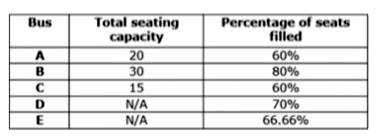A train started with 540 passengers. At the first stop 19 of them got down and 24 got up. On its second stop 18 of the passengers then existing got down and 9 got up. With how many passengers did it reach the third stop? (a) 450 (b) 500 (c) 540 (d) 550
Step by step video & image solution for A train started with 540 passengers. At the first stop 1/9 of them got down and 24 got up. On its second stop 1/8 of the passengers then existing got down and 9 got up. With how many passengers did it reach the third stop? (a) 450 (b) 500 (c) 540 (d) 550 by Maths experts to help you in doubts & scoring excellent marks in Class 14 exams.
Similar Questions
A train started from a station with a certain number of passengers. At the first halt, half of the passengers got down and 125 passengers got in. At the second halt, half of the passengers left and 100 entered. Then the train left for its destination with 250 passengers. The number of passengers in the train at the start was (a) 250 (b) 350 (c) 450 (d) 550
View Solution40% of the passengers from a train got down at station X, 75% of the remaining got down at station Y .If the remaining 12 were taken to station Z ,how many passengers were there in the train?
View Solution
Knowledge Check
- Question 1 - Select One
A bus left with some definite number of passengers. At the first stop, half the passengers left the bus and 35 boarded the bus. At the second stop 15 th of the passengers left and 40 boarded the bus. Then, the bus moved with 80 passengers towards its destination without stopping anywhere. How many passengers were there originally?
A25B30C40D50 - Question 2 - Select One
A bus left with some definite number of passengers. At the first stop, half the passengers left the bus and 35 boarded the bus. At the second stop 15th of the passengers left and 40 boarded the bus. Then, the bus moved with 80 passengers towards its destination without stopping anywhere. How many passengers were there originally?
A25B30C40D50 - Question 3 - Select One
When a train started from station A, there were certain number of passengers in it. On the next station, 111 of these passengers got down and 20% of these got down passengers got into the train. Now if the number of passengers in the train is 510, how many passengers were there at station A?
A600B580C560D550
From a number of apples, a man sells half the number of existing apples plus 1 to the first customer, sells 13rd of the remaining apples plus 1 to the second customer and 15th of the remaining apples plus 1 to the third customer. He then finds that he has 3 apples left. How many apples did he have originally? (a) 15 (b) 18 (c) 20 (d) 25
View SolutionThe average age of a husband and wife at the time of their marriage was 25 years. A son was born to them two years after their marriage. The present average age of all three of them is 24 years. How many years is it since the couple got married? (a) 5 years (b) 6 years (c) 8 years (d) 9 years
View SolutionSome passengers travel in a train 13 rd of the passengers stepped down on the first station and 560 passengers entered the train, half of the total passengers stepped down on the second station and 24 more passengers entered in the train and on the third station all 496 passengers stepped down. How many passengers were travelling in the train in the beginning?
View SolutionWhen a bus started from the first stop, the number of male passengers to the number of female passengers was 3 : 1. At the stop 16 passengers get down and 6 more female passengers get into. Now the ratio of the male to female passengers becomes 2 : 1. What was the total number of passengers in the bus when it started from the first stop?
View SolutionStudy the given information carefully and answer the questions that follow.
The table given below shows the capacity of 5 buses (A, B, C, D, E) and the percentage of seats that were filled out of the total seating capacity of the buses.

Some of the data is missing and is denoted as N/A
A) The total number fo vacant seats in all the 5 nuses together were 40
B) The number of seats in buses D and E together were 65
20% of the passengers on bus D got down at Yarivali bus stop and 2 passengers boarded the bus from the same bus stop. The conductor started charging from Yarivali bus stop. The number of adults and children on he bus were in the ratio 2:1. If the total collection of bus fare was Rs. 800, what was the bus fare for each child? Consider, there were no other stoppages till the final stop, The bus ticket was free till Yarivali bus stop and children's tricket price was half of that of adult.View Solution

